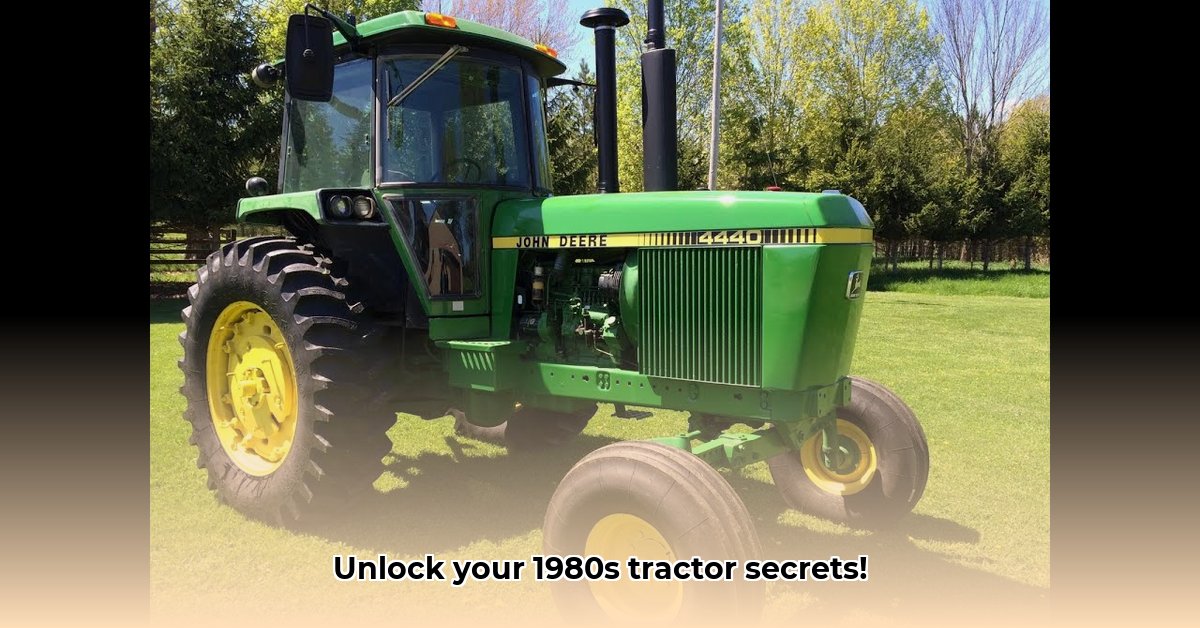
1980 Tractor Market Overview: A Buyer's Guide
The 1980s witnessed a diverse range of tractors, each with unique features and challenges. This market offers a blend of nostalgia, practicality, and potential pitfalls for various stakeholders. Whether you're a collector, farmer, parts supplier, or restoration shop owner, navigating this landscape requires understanding its nuances. This guide equips you with the knowledge and strategies to make informed decisions and mitigate potential risks. Did you know that accurately pricing 1980s tractors is surprisingly difficult due to the lack of comprehensive data? 1 This underlines the importance of thorough research and inspections. For example, see this Ford 1910 resource for more information.
For Collectors and Hobbyists: Preserving Agricultural History
Owning a classic 1980s tractor is a rewarding endeavor. It requires patience, skill, and a strategic approach to parts acquisition and restoration.
Identify Desirable Models: Research different brands (John Deere, Case IH, Ford, etc.) and models, considering rarity, historical significance, and restoration potential. Joining online forums (like Yesterday's Tractors) is a great way to connect with fellow enthusiasts and learn about specific models.
Locate Parts: Sourcing parts is crucial. Explore online marketplaces, specialized dealers, and even consider 3D printing for less critical components. Remember, readily available parts mean a smoother restoration.
Perform Basic Inspections: Before purchasing, meticulously inspect the engine, hydraulic system, and transmission for leaks, damage, and signs of previous repairs. Considering engaging a qualified mechanic for a thorough evaluation.
Prioritize Restoration Steps: Depending on your skill and budget, prioritize restoration steps. Addressing critical mechanical issues before cosmetic concerns maximizes your investment.
For Small-Scale Farmers: Reliable Power for Modern Needs
A 1980s tractor can be a cost-effective solution for small farms, offering dependable power for various tasks. Choosing the right model, however, requires careful assessment of your requirements.
Match Tractor to Farming Needs: Determine the horsepower, features (three-point hitch, PTO), and overall size suitable for your acreage and crop types. A tractor too large or too small can reduce efficiency.
Prioritize Mechanical Reliability: Focus on tractors with well-maintained engines, hydraulics, and transmissions. Opt for models with readily available parts to minimize downtime.
Implement Cost-Effective Maintenance: Regular preventative maintenance is paramount. Learn basic maintenance techniques to reduce reliance on expensive repairs.
Build Strong Supplier Relationships: Establishing a relationship with a parts supplier or local mechanic ensures quick access to repairs and minimizes potential delays.
For Parts Suppliers: Meeting the Consistent Demand
The market for 1980s tractor parts remains surprisingly robust. Understanding this market and the needs of various user groups is key to success.
Identify High-Demand Parts: Research the most common components needing replacement across different tractor models. Focus on these parts to maximize profitability.
Develop Strategic Sourcing: Explore different sourcing avenues, including domestic and international suppliers, as well as junkyards (remember safety precautions).
Explore Modern Manufacturing: Consider using 3D printing or other modern manufacturing techniques to reproduce hard-to-find components. This may differentiate your offerings and expand your market.
Build Relationships with Restoration Shops: Collaborating with restoration shops ensures a consistent supply of parts and creates partnerships.
For Restoration Shops: Building a Successful Business
Specializing in particular brands or models of 1980s tractors allows you to build expertise and attract a loyal clientele.
Specialize in Specific Models: Focusing on certain tractor brands allows you to develop in-depth knowledge, and build a strong reputation.
Create a Strong Online Presence: Build a website and use social media to connect with clients. Showcase your restoration skills and expertise.
Build Relationships with Suppliers: Develop relationships with parts suppliers to ensure timely access to necessary components.
Offer Additional Services: Consider offering custom fabrication or broader mechanical services to diversify income streams.
Legal Considerations: Navigating Regulations
Before beginning any work, ensure compliance with local regulations. These regulations may vary by location and can affect sourcing or modifying a 1980 tractor. Always prioritize safety and environmental compliance.
Conclusion: Your 1980 Tractor Journey
This comprehensive guide provides a powerful framework for navigating the world of 1980s tractors. Remember, careful planning and a proactive approach will lead to success, whether you are a collector, farmer, parts supplier, or restoration shop owner. The journey of finding and maintaining your 1980s tractor is an exciting one; do your research, stay informed, and enjoy the process!